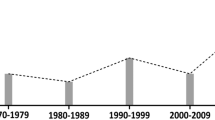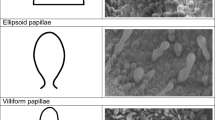Abstract
Epidermal surfaces of about 500 species from some 250 genera of centrospermous families plus some possibly related families were examined by scanning electron microscopy. The micromorphology of their epicuticular waxes is described under taxonomic aspects. In general, Centrosperms tend to develop wax platelets on their cuticle. Shape and size of these platelets are highly diverse, but specific for some taxa. Particular forms of rodlets and thick wax plates occur only in few taxa. The systematic and taxonomic applicability of wax micromorphology is limited, but tentatively family characterizations are given. The data presented provide additional information concerning the familiar and suprafamiliar classification ofCaryophyllales.
Similar content being viewed by others
References
Baker, E. A., 1982: Chemistry and morphology of plant epicuticular waxes. — InCutler, D., Alvin, K. L., Price, C. E., (Eds.): The plant cuticle, pp. 139–165. — London: Academic Press.
Barthlott, W., Ehler, N., 1977: Raster-Elektronenmikroskopie der Epidermis-Oberflächen von Spermatophyten. — Trop. subtrop. Pflanzenwelt19: 367–467. — Wiesbaden: Steiner.
—, 1983: Mikromorphologie und Orientierungsmuster epicutiuclarer Wachs-Kristalloide: Ein neues systematisches Merkmal bei Monocotylen. — Pl. Syst. Evol.142: 171–185.
—, 1981: Zur Feinstruktur, Chemie und taxonomischen Signifikanz epicuticularer Wachse und ähnlicher Sekrete. — Trop. subtrop. Pflanzenwelt32: 35–97. — Wiesbaden: Steiner.
Bedell, H. G., 1980: A taxonomic and morphological re-evaluation ofStegnospermataceae (Caryophyllales). — Syst. Bot.5: 419–431.
Behnke, H.-D., 1976a: Sieve-element plastids ofFouquieria, Frankenia (Tamaricales) andRhabdodendron (Rutaceae), taxa sometimes allied withCentrospermae (Caryophyllales). — Taxon25: 265–268.
—, 1976b: Ultrastructure of sieve-element plastids inCaryophyllales (Centrospermae), evidence for the delimitation and classification of the order. — Pl. Syst. Evol.126: 31–54.
—, 1976c: A tabulated survey of some characters of systematic importance in centrospermous families. — Pl. Syst. Evol.126: 95–98.
—, 1983: Ultrastructural, micromorphological and phytochemical evidence for a “central position” ofMacarthuria (Molluginaceae) within theCaryophyllales. — Pl. Syst. Evol.143: 151–161.
Bentham, G., Hooker, J. D., 1862: Genera Plantarum I. — London: A. Black, W. Pamplin, L. Reeve & Co., Williams & Norgate.
—, 1880: Genera Plantarum III. — London: L. Reeve & Co., Williams & Norgate.
Cronquist, A., 1968: The evolution and classification of flowering plants. — London: T. Nelson.
—, 1981: An integrated system of classification of flowering plants. — New York: Columbia University Press.
Cutler, D. F., Alvin, K. L., Price, C. E., (Eds.) 1982: The plant cuticle. — London: Academic Press.
Dahlgren, R., 1975: A system of classification of the angiosperms used to demonstrate the distribution of characters. — Bot. Notiser128: 119–147.
—, 1980: A revised system of classification of the angiosperms. — Bot. J. Linn. Soc.80: 91–124.
—, 1976: Iridoid components inFouquieriaceae and notes on its possible affinities. — Bot. Notiser129: 207–212.
Eckardt, T., 1964: ReiheCentrospermae. — InMelchior, H., (Ed.):A. Engler's Syllabus der Pflanzenfamilien2, 12th edn., pp. 79–101. — Berlin: Bornträger.
—, 1976: Classical morphological features of centrospermous families. — Pl. Syst. Evol.126: 5–25.
Ehrendorfer, F., 1976: Chromosome numbers and differentiation of centrospermous families. — Pl. Syst. Evol.126: 27–30.
—, 1983: Evolution und Systematik. — InDenffer, D., Ziegler, H., Ehrendorfer, F., Bresinsky, A., (Rev.): Lehrbuch der Botanik, founded byE. Strasburger & al., 32nd edn. — Stuttgart, New York: Gustav Fischer.
Hallier, H., 1901: Über die Verwandtschaftsverhältnisse der Tubifloren und Ebenalen, den polyphyletischen Ursprung der Sympetalen und Apetalen und die Anordnung der Angiospermen überhaupt. — Abh. Geb. Naturwiss. (Hamburg)16: 1–112.
Henrickson, J., 1972: A taxonomic revision of theFouquieriaceae. — Aliso7: 439–537.
Heywood, V. H., (Ed.), 1979: Flowering plants of the world. Oxford: Oxford University Press.
Hora, F. B., 1979:Phytolaccaceae. — InHeywood, V. H., (Ed.): Flowering plants of the world, pp. 71–72. — Oxford: Oxford University Press.
Hunt, D. R., Taylor, N. P., (Eds.), 1986: The genera of theCactaceae: towards a new consensus. — Bradleya4: 65–78.
Hutchinson, J., 1969: Evolution and phylogeny of flowering plants. — London: Academic Press.
—, 1973: The families of flowering plants, 3rd edn. — Oxford: Clarendon Press.
Ihlenfeldt, H.-D., Hartmann, H. E. K., 1982: Leaf surfaces inMesembryanthemaceae. — InCutler, D. F., Alvin, K. L., Price, C. E., (Eds.): The plant cuticle, pp. 379–423. — London: Academic Press.
Jeffrey, C. E., Baker, E. A., Holloway, P. J., 1976: Origins of the fine structure of plant epicuticular waxes. — InDickinson, C. H., Preece, T. F., (Eds.): Microbiology of aerial plant surfaces, pp. 119–158. — London: Academic Press.
Juniper, B. E., 1959: Growth, development and effect of environment on the ultrastructure of plant surfaces. — J. Linn. Soc.56: 413–419.
Martin, J. T., Juniper, B. E., 1970: The cuticle of plants. — London: Edward Arnold.
Melchior, H., (Ed.), 1964:A. Engler's Syllabus der Pflanzenfamilien2: 12th edn. — Berlin: Bornträger.
Moquin-Tandon, A., 1849:Phytolaccaceae. — InDe Candolle, A. (Ed.): Prodromus systematis naturalis regni vegetabilis13/2, pp. 16–40. — Paris: Victor Masson.
Nowicke, J. W., 1975: Preliminary survey of pollen morphology in the orderCentrospermae. — Grana15: 51–77.
—, 1977: Pollenmorphology and the relationship of thePlumbaginaceae, Polygonaceae andPrimulaceae to the orderCentrospermae. — Smithsonian Contr. Bot.37: 1–64.
Pax, F., 1889:Aizoaceae. — InEngler, A., Prantl, K., (Eds.): Die natürlichen Pflanzenfamilien3, 1 b, 1st edn., pp. 33–51. — Leipzig: Engelmann.
—, 1934:Caryophyllaceae. — InEngler, A., Harms, H., (Eds.): Die natürlichen Pflanzenfamilien16c, founded byEngler, A., Prantl, K., 2nd edn., pp. 275–364. — Leipzig: Engelmann.
Richardson, R. M., 1981: Flavonoids of some controversial members of theCaryophyllales (Centrospermae). — Pl. Syst. Evol.138: 227–233.
Schill, R., Barthlott, W., Ehler, N., Rauh, W., 1973: Rasterelektronenmikroskopische Untersuchungen an Cactaceen-Epidermen und ihre Bedeutung für die Systematik. — Trop. subtrop. Pflanzenwelt4: 1–13. — Wiesbaden: Steiner.
Schinz, H., 1934:Amaranthaceae. — InEngler, A., Harms, H., (Eds.): Die natürlichen Pflanzenfamilien16c, founded byEngler, A., Prantl, K., 2nd edn., pp. 7–85. — Leipzig: Engelmann.
Takhtajan, A. L., 1980: Outline of the classification of flowering plants (Magnoliophyta). — Bot. Rev.46: 225–359.
Thorne, R. F., 1983: Proposed realignments in the angiosperms. — Nordic J. Bot.3: 85–117.
Ulbrich, E., 1934:Theligonaceae. — InEngler, A., Harms, H., (Eds.): Die natürlichen Pflanzenfamilien16c, founded byEngler, A., Prantl, K., 2nd edn., pp. 368–378. — Leipzig: Engelmann.
Author information
Authors and Affiliations
Additional information
Dedicated to the enthusiast of succulent Centrosperms, Prof. DrK. E. Wohlfarth-Bottermann (Director of the Institute of Cytology and Micromorphology, University of Bonn) on the occasion of his 65th birthday in May 1988.
Rights and permissions
About this article
Cite this article
Engel, T., Barthlott, W. Micromorphology of epicuticular waxes in Centrosperms. Pl Syst Evol 161, 71–85 (1988). https://doi.org/10.1007/BF00936014
Received:
Issue Date:
DOI: https://doi.org/10.1007/BF00936014




